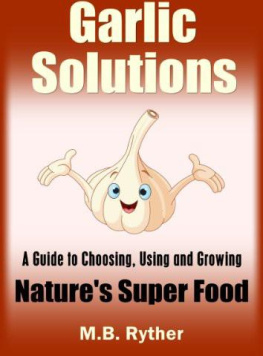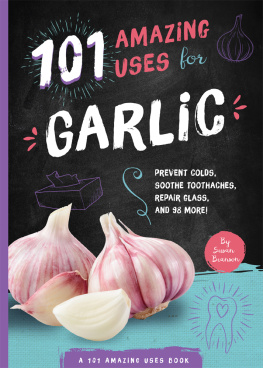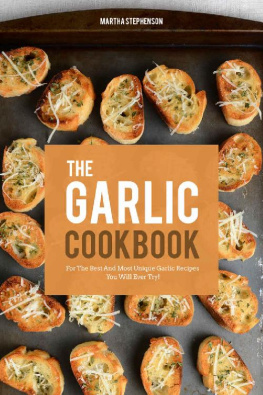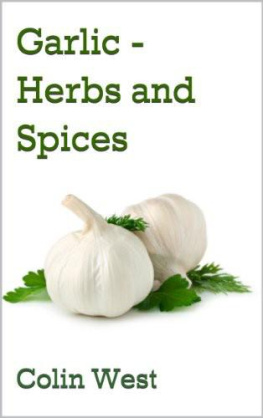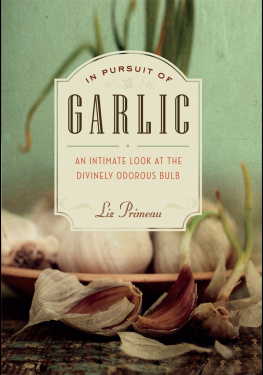GARLIC SOLUTIONS
A GUIDE TO CHOOSING, USING AND GROWING NATURES SUPER FOOD
M.B. Ryther
Copyright 2013 M.B. Ryther
All rights reserved. No part of this book may be used or reproduced in any manner whatsoever without written permission from the author, except in the case of brief quotations embodied in critical articles and reviews.
Disclaimer This book is not intended as a substitute for the medical advice of physicians. The reader should regularly consult a physician in matters relating to his/her health and particularly with respect to any symptoms that may require diagnosis or medical attention.
Table of Contents
Garlic: Natures Super Food
Garlic is as good as ten mothers.
Chinese proverb
There are few foods that are as widely revered, universally adopted, and as steeped in lore and legend as "the stinking rose," otherwise known as garlic. Its culinary prowess can turn a bland dish into a memorable one, and its health benefits include everything from lowered blood pressure to improved heart health. Some of the most exciting recent medical research links garlic consumption to protection against infection, environmental toxins, and even cancer.
And while its legendary ability to ward off vampires has yet to be proven, it will keep little monsters off your plants, according to the Environmental Protection Agency (EPA), which officially lists garlic as a non-toxic pest control substance. This is just an introduction, for as youll soon discover, the list of garlic pluses and positives goes on and on.
Which brings us to the purpose of this book: To present to you the wonders of garlic in a simplified, organized, and useful manner so you can start reaping the benefits of this powerful little plant right away. In these pages you'll find tips on how to grow your own garlic, store it, prepare it, eat it, and use it for a variety of purposes, some of which might surprise you. (Fish bait or facialyour choice!)
But first, Id like to take a short trip back in time to the origins and early uses of this miracle food. What's truly amazing is how imbedded garlic was in the cultures of so many ancient civilizations. What's also amazing is how in so many instances ancient wisdom has been proven right by modern science.
Garlic Through The Ages
The word "garlic" comes from the Old English word "gar," which means "spear," referring to the plant's spear-shaped leaves. It is widely believed that garlic originated in Central Asia and southwestern Siberia, its cultivation eventually spreading east towards China and west towards Europe.
The ancient Sumerians are credited with the earliest written mention of garlic. A Sumerian clay tablet dating back to 2600 BC named the herb on a list of dietary staples. A thousand years later, in 1550 BC, garlic was prominently featured in the Codex Ebers, a medical text from ancient Egypt. Of the hundreds of herbal remedies mentioned in the text, 22 of them included garlic for the treatment of a variety of medical conditions, including tumors and heart ailments.
We know from artwork and sculptures, papyrus writings, and tomb and temple texts that garlic was highly esteemed in ancient Egypt. It was particularly recognized for its ability to strengthen the body and ward off infection. According to Greek historian Herodotus, the slaves who built the Great Pyramid of Cheops at Giza were given loads of garlic, onions, and radishes to fuel their work. Garlic was so valued it was even used as currency on occasion. A healthy male slave in ancient Egypt could be purchased for fifteen pounds of garlic.
The ancient Greeks also believed in the power of garlic. Greek soldiers ingested it to steel themselves for war. Greek athletes took it to improve their performances in the Olympic games. The famous Greek physician Hippocrates prescribed garlic as a laxative and a diuretic, as well as a treatment for uterine tumors and lung disease. Aristotle wrote of garlics use as a medicinal remedy, and in particular its usefulness as an aphrodisiac. But as much as the Greeks may have loved garlic for its performance-enhancing and medicinal qualities, they werent so keen on its smell. In fact, they considered garlic breath to be vulgar and offensive. They believed their gods shared this dislike as well, and forbade people from entering select temples if they smelled of garlic. On the other side of the supernatural spectrum, the Greeks held that garlic provided protection from witches, a belief that carried on through subsequent centuries.
Like the Greeks who flourished before them, the ancient Romans also prohibited worshipers from entering their temples after eating garlic. While not popular among the wealthier Romans, who looked down on garlic as a food for peasants and laborers, garlic was highly regarded by Romes soldiers and sailors, who ingested it abundantly for courage, fortitude, and overall healthfulness. The Romans, like the Greeks, also used garlic for medicinal purposes. In his 37-book encyclopedia of natural sciences, Historia Naturalis , Pliny the Elder (23-79 AD) listed 23 different ailments that garlic could be used to treat, including infection, a condition which modern research has shown garlic to be effective against. In another remarkable nod to the future discoveries of modern science, Neros chief physician, the Greek Dioscorides, wrote in his famous medical text Meteria Medica that garlic clears the arteries and opens the mouths of the veins.
In biblical times, garlic was also highly regarded. Hebrew laborers used it to enhance their strength and health. The one mention of garlic in the Bible, Numbers 11:6, expresses the dissatisfaction among the Israelites, after having been led out of Egypt by Moses, over the lack of garlic and other favored foods: We remember the fish which we used to eat free in Egypt, the cucumbers and the melons and the leeks and the onions and the garlic... In the Talmud, one of Judaisms core texts, instructions are given for using garlic as a food, medicine, and aphrodisiac.
After the fall of Rome, Christian monks became the chief keepers of herbal and medical knowledge, and consequently grew garlic in their monastery gardens along with other plants considered important and useful. Across Europe, people of all classes began valuing garlic for its medicinal qualities as well as its taste. The Duke of Normandy, Robert I, in the eleventh century wrote: Since garlic has the power to save from death, endure it though it gives bad breath. In Germany, the Christian mystic Saint Hildegard von Bingen taught that garlic should be eaten in moderation and that it ought to be eaten uncooked, because if it is cooked, its strength is lost.
As cultural changes swept across Europe during the fevered years of the Renaissance, garlic rode the wave and stayed afloat, maintaining its renowned stature as a medicinal plant. In 1652, British physician Nicholas Culpeper, in his monumental work The Complete Herbal , credited garlic with a plethora of healing powers. A leading Italian physician, Pietro Mattioli of Siena, prescribed garlic for worms, kidney disorders, digestive problems, and to mothers experiencing difficult childbirths.
Perhaps the most interesting use of garlic during these times occurred during the Plague years, when French gravediggers drank crushed garlic in wine to protect themselves from contracting the disease. Similarly, legend has it that thieves who robbed the dead and dying avoided the plague by wearing cotton masks soaked in a mixture of wine vinegar, herbs, and garlic, as well as rubbing the malodorous concoction all over their bodies. And finally, stories from that era maintain that French priests who ministered to plague victims avoided catching it themselves, while English priests were not so lucky. The difference? The French ate lots of garlic; the English, not so much.
The modern era changed garlics standings significantly. No longer the object of folklore, legends, and anecdotal surmising, garlic began being studied in laboratories and given the scientific validation its supporters through the centuries always knew but couldnt prove. French chemist Louis Pasteur was one of the first modern researchers to observe garlic's potential health benefits. In 1858 he placed some garlic cloves in a petri dish filled with bacteria. When he checked on the dish a few days later, he found that the bacteria had died off. Aware of its antibacterial properties, British doctors during World War I frequently used garlic as an antiseptic against infections. And in World War II, British and Russian doctors used a diluted garlic solution to disinfect open wounds, gaining it the nickname "Russian penicillin.
Next page
